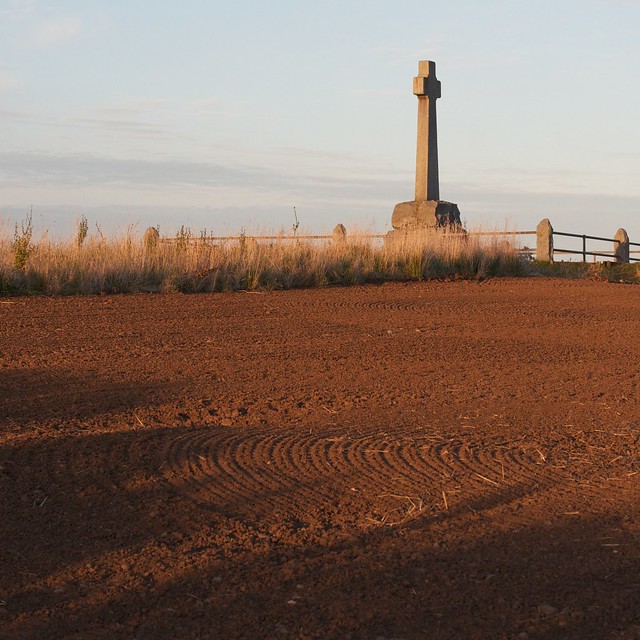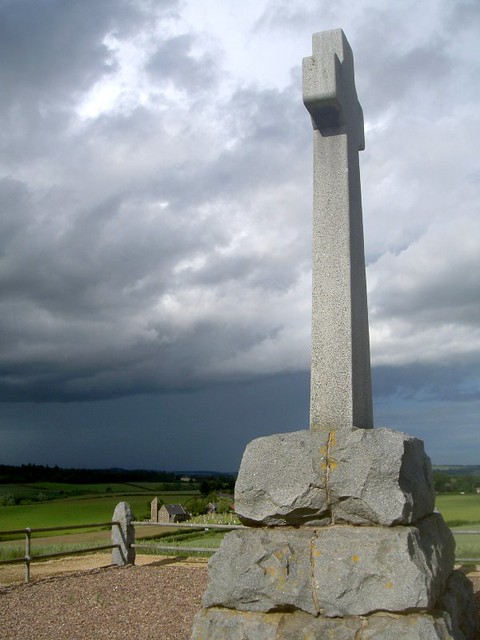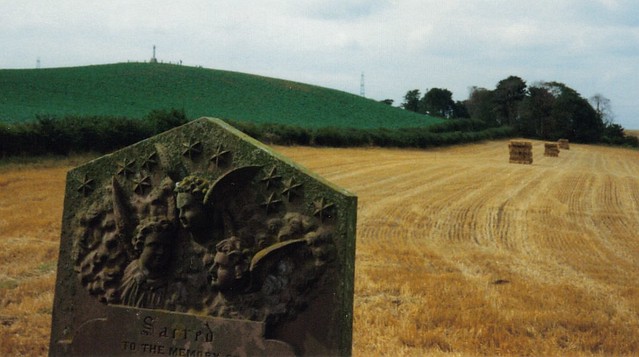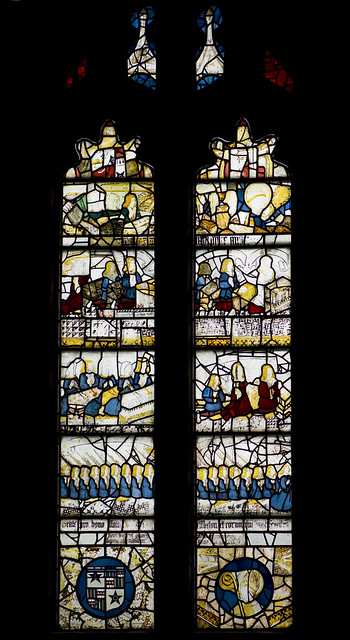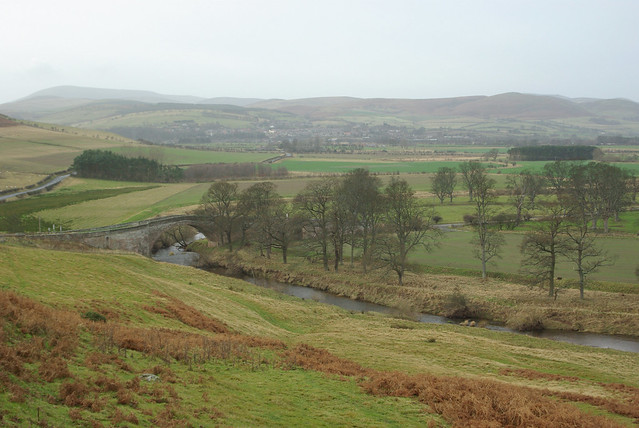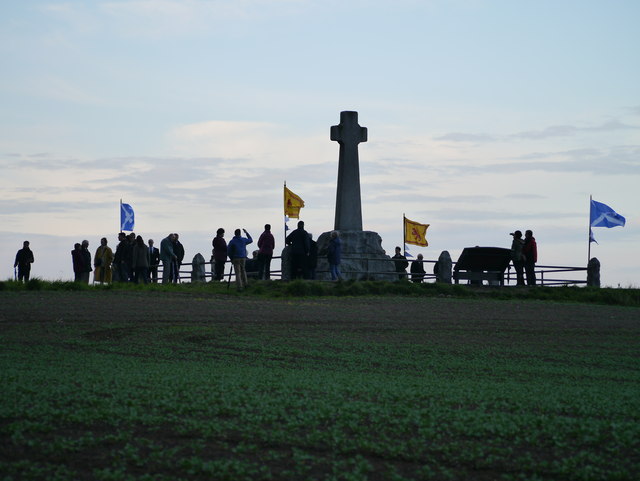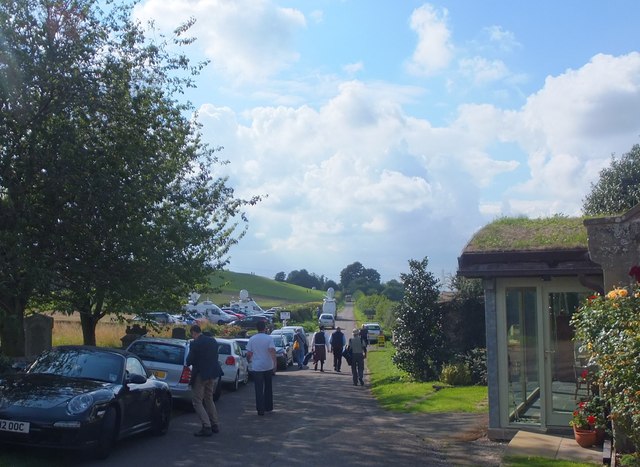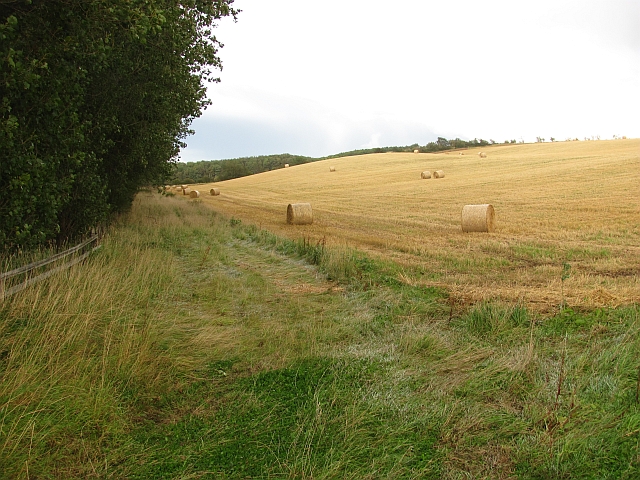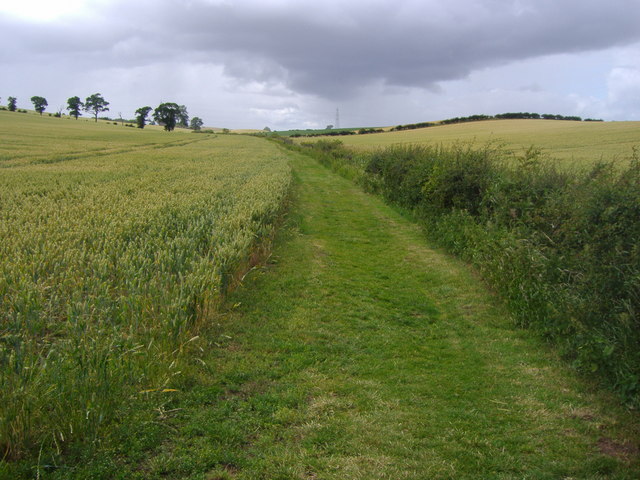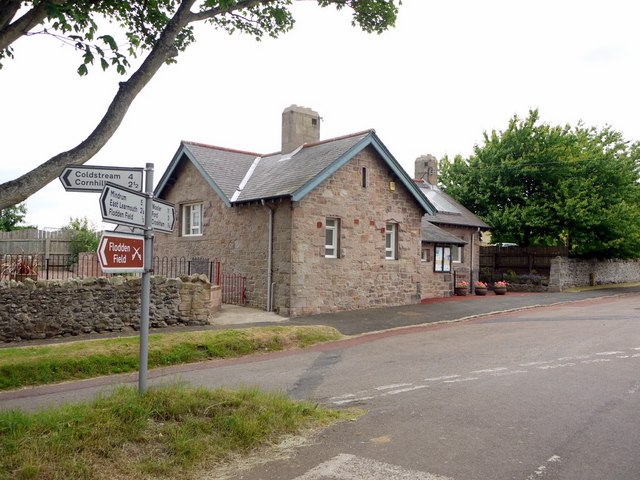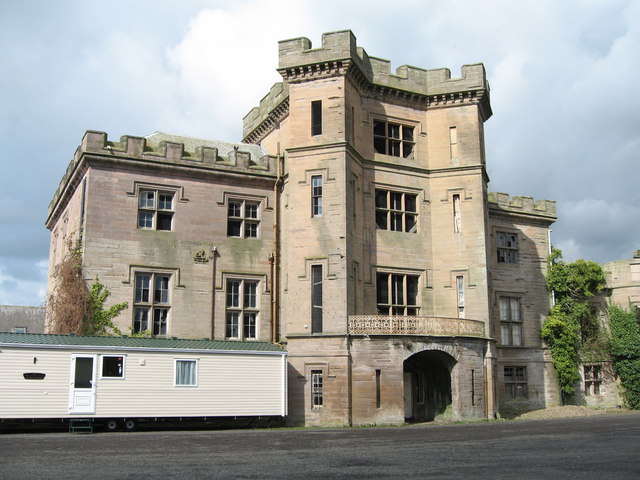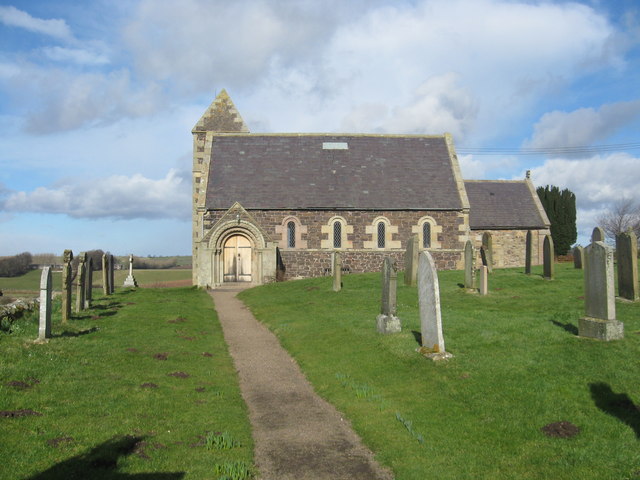Topics > Historical Periods > Tudor Period (1485 to 1603 AD) > Battle of Flodden, 1513
Battle of Flodden, 1513
The Battle of Flodden (or Flodden Field) near Branxton was fought between the English and the invading Scottish army on the 9th of September 1513. The Scottish army was led by King James IV, whilst the slightly smaller English army was commanded by the Earl of Surrey. Estimates vary, but between 60,000 and 100,000 men were involved in the battle. It was the largest battle fought between England and Scotland. Many thousands died in the battle, some buried at St Paul's Church in nearby Branxton. King James was killed in the battle and it was a decisive victory for the English victory.
The Battle of Flodden or Flodden Field, or occasionally Battle of Branxton (Brainston Moor), was part of a conflict between the Kingdom of England and the Kingdom of Scotland. The battle was fought in Branxton in the county of Northumberland in northern England on 9 September 1513, between an invading Scots army under King James IV and an English army commanded by the Earl of Surrey. It was a decisive English victory. In terms of troop numbers, it was the largest battle fought between the two Kingdoms. James IV was killed in the battle, becoming the last monarch from the island of Britain to suffer such a death.
Background
This conflict began when James IV, King of Scots declared war on England to honour the Auld Alliance with France by diverting Henry VIII's English troops from their campaign against the French king Louis XII. Henry VIII had also opened old wounds by claiming to be the overlord of Scotland, which angered the Scots and their King. At this time England was involved as a member of the "Catholic League" in the War of the League of Cambrai—defending Italy and the Pope from the French (see Italian Wars).
Pope Leo X, already a signatory to the anti-French Treaty of Mechlin, sent a letter to James threatening him with ecclesiastical censure for breaking his peace treaties with England on 28 June 1513, and subsequently James was excommunicated by Cardinal Christopher Bainbridge. James also summoned sailors and sent the Scottish navy, including the Great Michael, to join the ships of Louis XII of France.
Henry was in France with the Emperor Maximilian at the siege of Thérouanne. The Scottish Lyon King of Arms brought James IV's letter of 26 July to him. James asked him to desist from attacking France in breach of their treaty. Henry's exchange with Islay Herald or the Lyon King on 11 August at his tent at the siege was recorded. The Herald declared that Henry should abandon his efforts against the town and go home. Henry angrily replied that James had no right to summon him, and ought to be England's ally, as James was married to Henry's sister Margaret, declaring:And now, for a conclusion, recommend me to your master and tell him if he be so hardy to invade my realm or cause to enter one foot of my ground I shall make him as weary of his part as ever was man that began any such business. And one thing I ensure him by the faith that I have to the Crown of England and by the word of a King, there shall never King nor Prince make peace with me that ever his part shall be in it. Moreover, fellow, I care for nothing but for misentreating of my sister, that would God she were in England on a condition she cost the Schottes King not a penny.
Henry also replied by letter on 12 August that James was mistaken and that any of his attempts on England would be resisted. Using the pretext of revenge for the murder of Robert Kerr, a Warden of the Scottish East March who had been killed by John "The Bastard" Heron in 1508, James invaded England with an army of about 30,000 men. However, both sides had been making lengthy preparations for this conflict. Henry VIII had already organised an army and artillery in the north of England to counter the expected invasion. Some of the guns had been returned to use against the Scots by Margaret of Austria, Duchess of Savoy. A year earlier, Thomas Howard, Earl of Surrey, had been appointed Lieutenant-General of the army of the north and was issued with banners of the Cross of St George and the Red Dragon of Wales. Only a small number of the light horsemen of the Scottish border had been sent to France. A northern army was maintained with artillery and its expense account starts on 21 July 1513. The first captains were recruited in Lambeth. Many of these soldiers wore green and white Tudor colours. Surrey marched to Doncaster in July and then Pontefract. where he assembled more troops from Northern England.
Invasion
On 18 August, five cannon brought down from Edinburgh Castle to the Netherbow Gate at St Mary's Wynd for the invasion set off towards England dragged by borrowed oxen. On 19 August two 'gross culverins', four 'culverins pickmoyance' and six (mid-sized) 'culverins moyane' followed with the gunner Robert Borthwick and master carpenter John Drummond. The King himself set off that night with two hastily prepared standards of St Margaret and St Andrew.
Catherine of Aragon was Regent in England and on 27 August she issued warrants for the property of all Scotsmen in England to be seized. On hearing of the invasion on 3 September she ordered Thomas Lovell to raise an army in the Midland counties.
In keeping with his understanding of the medieval code of chivalry, King James sent notice to the English, one month in advance, of his intent to invade. This gave the English time to gather an army and to retrieve the banner of Saint Cuthbert from Durham Cathedral, a banner which had been carried by the English in victories against the Scots in 1138 and 1346. After a muster on the Burgh Muir of Edinburgh, the Scottish host moved to Ellemford, to the north of Duns, and camped to wait for Angus and Home. The Scottish army then crossed the River Tweed near Coldstream. On 24 August James IV held a council or parliament at Twiselhaugh and made a proclamation for the benefit of the heirs of anyone killed during this invasion. By 29 August Norham Castle was taken and partly demolished. The Scots moved south, capturing the castles of Etal and Ford.
A later Scottish chronicle writer, Robert Lindsay of Pitscottie, tells the story that James wasted valuable time at Ford enjoying the company of Elizabeth, Lady Heron and her daughter. Edward Hall says that Lady Heron was a prisoner (in Scotland), and negotiated with James IV and the Earl of Surrey her own release and that Ford Castle would not be demolished for an exchange of prisoners. The English herald, Rouge Croix, came to Ford to appoint a place for battle on 4 September, with extra instructions that any Scottish heralds who were sent to Surrey were to be met where they could not view the English forces. Raphael Holinshed's story is that a part of the Scottish army returned to Scotland, and the rest stayed at Ford waiting for Norham to surrender and debating their next move. James IV wanted to fight and considered moving to assault Berwick-upon-Tweed, but the Earl of Angus spoke against this and said that Scotland had done enough for France. James sent Angus home, and according to Holinshed, the Earl burst into tears and left, leaving his two sons, the Master of Angus and Glenbervie, with most of the Douglas kindred to fight.
Battle
The battle actually took place near the village of Branxton, in the county of Northumberland, rather than at Flodden—hence the alternative name is Battle of Branxton. The Scots had previously been stationed at Flodden Edge, to the south of Branxton. The Earl of Surrey, writing at Wooler Haugh on Wednesday 7 September, compared this position to a fortress in his challenge sent to James IV by Thomas Hawley, the Rouge Croix Pursuivant. He complained that James had sent his Islay Herald agreeing that they would join in battle on Friday between 12.00 and 3.00 pm, and asked that James would face him on the plain at Milfield as appointed.
Next, Surrey moved to block off the Scots' route north and so James was forced to move his army and artillery two miles to Branxton Hill. The Scottish artillery, as described by an English source, included five great curtals, two great culverins, four sakers, and six great serpentines. The King's secretary, Patrick Paniter was in charge of these cannon. When the armies were within three miles of each other Surrey sent the Rouge Croix pursuivant to James, who answered that he would wait till noon. At 11 o'clock, Thomas, Lord Howard's vanguard and artillery crossed the Twizel Bridge. (Pitscottie says the King would not allow the Scots artillery to fire on the vulnerable English during this manoeuvre.) The Scots army was in good order in five formations, after the Almain (German) manner. On Friday afternoon the Scots host descended without speaking any word to meet the English.
The English army had formed two "battles" each with two wings. Lord Howard combined his "vanguard" with the soldiers of his father's "rearward" to meet the Scots. According to English report, the groups commanded by the Earls of Huntly and Crawford and Erroll, totalling 6000 men, engaged Lord Howard and were repulsed and mostly slain.
Then James IV himself leading a great force came on to Surrey and Lord Darcy's son who "bore all the brunt of the battle". Lennox and Argyll's commands were met by Sir Edward Stanley.
After the artillery fire ended, according to the English chronicler Edward Hall, "the battle was cruel, none spared other, and the King himself fought valiantly". James was killed within a spear length from Surrey and his body taken to Berwick-upon-Tweed. Hall says the King was fatally wounded by an arrow and a bill. Meanwhile, Lord Howard's brother, Edmund Howard, commanding men from Cheshire and Lancashire, fought the section of the Scottish army commanded by the Chamberlain of Scotland, Alexander, Lord Home, and Thomas, Lord Dacre's force, who had been fighting Huntley, came to assist him.
The Earl of Surrey captured the Scottish guns, including a group of culverins made in Edinburgh by Robert Borthwick called the "seven sisters", which were dragged to Etal Castle. The Bishop of Durham thought them the finest ever seen. The treasurer of the English army Sir Philip Tilney valued seventeen captured guns as "well worth 1700 marks", and that 'the value of the getyng of thaym from Scotland is to the Kingis grace of muche more valew'.
Tactics and aftermath
Soon after the battle, the council of Scotland decided to send for help from Christian II of Denmark. The Scottish ambassador, Andrew Brounhill, was given instructions to explain "how this cais is hapnit." Brounhill's instructions blame James IV for moving down the hill to attack the English on marshy ground from a favourable position, and credits the victory to Scottish inexperience rather than English valour. The letter also mentions that the Scots placed their officers in the front line in medieval style who were vulnerable and killed, contrasting this loss of the nobility with the English great men who took their stand with the reserves and at the rear. The English generals stayed behind the lines in the Renaissance style. The loss of so many Scottish officers meant there was no one to coordinate a retreat.
However, according to contemporary English reports, Thomas Howard marched on foot leading the English vanguard to the foot of the hill. Howard was moved to dismount and do this by taunts of cowardice sent by James IV's heralds, apparently based on his role at sea and the death two years earlier of the Scottish naval officer Sir Andrew Barton. A version of Howard's declaration to James IV that he would lead the vanguard and take no prisoners was included in later English chronicle accounts of the battle. Howard claims his presence in "proper person" at the front is his trial by combat for Barton's death.
Weaponry
Flodden was essentially a victory of the bill used by the English over the pike used by the Scots. The pike was an effective weapon only in a battle of movement, especially to withstand a cavalry charge. The Scottish pikes were described by the author of the Trewe Encounter as "keen and sharp spears 5 yards long". Although the pike had become a Swiss weapon of choice and represented modern warfare, the hilly terrain of Northumberland, the nature of the combat, and the slippery footing did not allow it to be employed to best effect. Bishop Ruthall reported to Thomas Wolsey, 'the bills disappointed the Scots of their long spears, on which they relied.' The infantrymen at Flodden, both Scots and English, had fought essentially like their ancestors, and Flodden has rightly been described as the last great medieval battle in the British Isles. This was the last time that bill and pike would come together as equals in battle. Two years later Francis I defeated the Swiss pikemen at the Battle of Marignano, using a combination of heavy cavalry and artillery, ushering in a new era in the history of war. An official English diplomatic report issued by Brian Tuke noted the Scots' iron spears and their initial "very good order after the German fashion", but concluded that "the English halberdiers decided the whole affair, so that in the battle the bows and ordnance were of little use."
Despite Tuke's comment (he was not present), this battle was one of the first major engagements in the British Isles where artillery was significantly deployed. John Lesley, writing sixty years later, noted that the Scottish bullets flew over the English heads while the English cannon was effective: the one army placed so high and the other so low.
The Scots advance down the hill was resisted by a hail of arrows, an incident celebrated in later English ballads. Hall says that the armoured front line was mostly unaffected; this is confirmed by the ballads which note that some few Scots were wounded in the scalp and, wrote Hall, James IV sustained a significant arrow wound. Many of the archers were recruited from Lancashire and Cheshire. Sir Richard Assheton raised one such company from Middleton, near Manchester. He rebuilt his parish church St. Leonard's, Middleton, which contains the unique "Flodden Window." It depicts and names the archers and their priest in stained glass. The window has been called the oldest known war memorial in the UK. The success of the Cheshire yeomanry, under the command of Richard Cholmeley, led to his later appointment as Lieutenant of the Tower of London.
Honours
As a reward for his victory, Thomas Howard was subsequently restored to the title of "Duke of Norfolk", lost by his father's support for Richard III. The arms of the Dukes of Norfolk still carry an augmentation of honour awarded on account of their ancestor's victory at Flodden, a modified version of the Royal coat of arms of Scotland with the lower half of the lion removed and an arrow through the lion's mouth.
At Framlingham Castle the Duke kept two silver-gilt cups engraved with the arms of James IV, which he bequeathed to Cardinal Wolsey in 1524. The Duke's descendants presented the College of Arms with a sword, a dagger, and a turquoise ring in 1681. The family tradition was either that these items belonged to James IV, or were arms carried by Thomas Howard at Flodden. The sword blade is signed by the maker Maestre Domingo of Toledo. There is some doubt whether the weapons are of the correct period. The Earl of Arundel was painted by Philip Fruytiers, following Anthony van Dyck's 1639 composition, with his ancestor's sword, gauntlet and helm from Flodden. Thomas Lord Darcy retrieved a powder flask belonging to James IV and gave it to Henry VIII. A cross with rubies and sapphires with a gold chain worn by James and a hexagonal table-salt with the figure of St Andrews on the lid were given to Henry by James Stanley, Bishop of Ely.
Legends of a lost king
Lord Dacre discovered the body of James IV on the battlefield. He later wrote that the Scots "love me worst of any Inglisheman living, by reason that I fande the body of the King of Scotts." The chronicle writer John Stow gave a location for the King's death; "Pipard's Hill," now unknown, which may have been the small hill on Branxton Ridge overlooking Branxton church. Dacre took the body to Berwick-upon-Tweed, where according to Hall's Chronicle, it was viewed by the captured Scottish courtiers William Scott and John Forman who acknowledged it was the King's. (Forman, the King's sergeant-porter, had been captured by Richard Assheton of Middleton.) The body was then embalmed and taken to Newcastle upon Tyne. From York, a city that James had promised to capture before Michaelmas, the body was brought to Sheen Priory near London. A payment of £12-9s–10d was made for the "sertying ledying and sawdryng of the ded course of the King of Scottes" and carrying it York and to Windsor.
James's banner, sword and his cuisses, thigh-armour, were taken to the shrine of Saint Cuthbert at Durham Cathedral. Much of the armour of the Scottish casualties was sold on the field, and 350 suits of armour were taken to Nottingham Castle. A list of horses taken at the field runs to 24 pages.
Thomas Hawley, the Rouge Croix pursuivant, was first with news of the victory. He brought the "rent surcoat of the King of Scots stained with blood" to Catherine of Aragon at Woburn Abbey. She sent news of the victory to Henry VIII at Tournai with Hawley, and then sent John Glyn on 16 September with James's coat (and iron gauntlets) and a detailed account of the battle written by Lord Howard. Brian Tuke mentioned in his letter to Cardinal Bainbridge that the coat was lacerated and chequered with blood. Catherine suggested Henry should use the coat as his battle-banner, and wrote she had thought to send him the body too, as Henry had sent her the Duke of Longueville, his prisoner from Thérouanne, but "Englishmen's hearts would not suffer it."
Soon after the battle there were legends that James IV had survived; a Scottish merchant at Tournai in October claimed to have spoken with him, Lindsay of Pitscottie records two myths; "thair cam four great men upon hors, and every ane of thame had ane wisp upoun thair spear headis, quhairby they might know one another and brought the king furth of the feild, upoun ane dun hackney," and also that the king escaped from the field but was killed between Duns and Kelso. Similarly, John Lesley adds that the body taken to England was "my lord Bonhard" and James was seen in Kelso after the battle and then went secretly on pilgrimage in far nations.
A legend arose that James had been warned against invading England by supernatural powers. While he was praying in St Michael's Kirk at Linlithgow, a man strangely dressed in blue had approached his desk saying his mother had told him to say James should not to go to war or take the advice of women. Then before the King could reply, the man vanished. David Lindsay of the Mount and John Inglis could find no trace of him. The historian R. L. Mackie wondered if the incident really happened as a masquerade orchestrated by an anti-war party: Norman Macdougall doubts if there was a significant anti-war faction. Three other portents of disaster were described by Paolo Giovio in 1549 and repeated in John Polemon's 1578 account of the battle. When James was in council at the camp at Flodden Edge a hare ran out of his tent and escaped the weapons of his knights; it was found that mice had gnawed away the strings and buckle of the King's helmet; and in the morning his tent was spreckled with a bloody dew.
Scotland after Flodden
The wife of James IV, Margaret Tudor, is said to have awaited news of her husband at Linlithgow Palace, where a room at the top of a tower is called 'Queen's Margaret's bower'. Ten days after the Battle of Flodden, the Lords of Council met at Stirling on the 19 September, and set up a General Council of the Realm "to sit upon the daily council for all matters occurring in the realm" of thirty-five lords including clergyman, lords of parliament, and two of the minor barons, the lairds of The Bass and Inverrugy. This committee was intended to rule in the name of Margaret Tudor and her son James V of Scotland.
The full Parliament of Scotland met at Stirling Castle on 21 October, where the 17-month-old King was crowned in the Chapel Royal. The General Council of Lords made special provisions for the heirs of those killed at Flodden, following a declaration made by James IV at Twiselhaugh, and protection for their widows and daughters. Margaret Tudor remained guardian or 'tutrix' of the King, but was not made Regent of Scotland.
The French soldier Antoine d'Arces arrived at Dumbarton Castle in November with a shipload of armaments which were transported to Stirling. The English already knew the details of this planned shipment from a paper found in a bag at Flodden field. Now that James IV was dead, Antoine d'Arces promoted the appointment of John Stewart, Duke of Albany, a grandson of James II of Scotland as Regent to rule Scotland instead of Margaret and her son. Albany, who lived in France, came to Scotland on 26 May 1515. By that date Margaret had given birth to James's posthumous son Alexander and married the Earl of Angus.
A later sixteenth century Scottish attitude to the futility of the battle was given by Robert Lindsay of Pitscottie, in the words he attributed to Patrick Lord Lindsay at council before the engagement. Lord Lindsay advised the King withdraw, comparing their situation to an honest merchant playing dice with a trickster, and wagering a gold rose-noble against a bent halfpenny. Their King was the gold piece, England the trickster, and Thomas Howard the halfpenny.
Casualties
Surrey's army lost 1,500 men killed in battle. There were various conflicting accounts of the Scottish loss. A contemporary account produced in French for the Royal Postmaster of England, in the immediate aftermath of the battle, states that about 10,000 Scots were killed, a claim repeated by Henry VIII on 16 September while he was still uncertain of the death of James IV. William Knight sent the news from Lille to Rome on 20 September, claiming 12,000 Scots had died with less than 500 English casualties. Italian newsletters put the Scottish losses at 18 or 20 thousand and the English at 5000. Brian Tuke, the English Clerk of the Signet, sent a newsletter stating 10,000 Scots killed and 10,000 escaped the field. Tuke reckoned the total Scottish invasion force to have been 60,000 and the English army at 40,000. George Buchanan wrote in his History of Scotland (published in 1582) that, according to the lists that were compiled throughout the counties of Scotland, there were about 5,000 killed. A plaque on the monument to the 2nd Duke of Norfolk (as the Earl of Surrey became in 1514) at Thetford put the figure at 17,000. Edward Hall, thirty years after, wrote in his Chronicle that "12,000 at the least of the best gentlemen and flower of Scotland" were slain.
As the nineteenth century antiquarian John Riddell supposed, nearly every noble family in Scotland would have lost a member at Flodden. The dead are remembered by the song (and pipe tune) "Flowers of the Forest":
We'll hae nae mair lilting, at the yowe-milking,
Women and bairns are dowie and wae.
Sighing and moaning, on ilka green loaning,
The flowers of the forest are all wede away.
Contemporary English ballads also recalled the tragedy of the Scottish losses:
To tell you plaine, twelve thousand were slaine,
that to the fight did stand;
And many prisoners tooke that day,
the best in all Scotland.
That day made many a fatherlesse childe,
and many a widow poore;
And many a Scottish gay Lady,
sate weeping in her bowre.
A legend grew that while the artillery was being prepared in Edinburgh before the battle, a demon called Plotcock had read out the names of those who would be killed at the Mercat Cross on the Royal Mile. According to Pitscottie, a former Provost of Edinburgh, Richard Lawson, who lived nearby, threw a coin at the Cross to appeal against this summons and survived the battle.
Branxton Church was the site of some burials from the battle of Flodden.
After Flodden many Scottish nobles are believed to have been brought to Yetholm for interment, as being the nearest consecrated ground in Scotland.
Notable Scotsmen who died
- James IV, King of Scots (1488–1513)
Clergy
- Alexander Stewart, Archbishop of St. Andrews and Lord Chancellor of Scotland, natural son of James IV
- George Hepburn, Bishop of the Isles and commendator of Arbroath and Iona
- William Bunche, Abbot of Kilwinning
- Laurence Oliphant, Abbot of Inchaffray
- Sir William Knollys, Lord St. John, Lord High Treasurer of Scotland, prior of Torphichen Preceptory.
- Archibald Campbell, 2nd Earl of Argyll
- John Stewart, 1st Earl of Atholl[dubious – discuss]
- Adam Hepburn, 2nd Earl of Bothwell Lord High Admiral of Scotland
- David Kennedy, 1st Earl of Cassilis
- William Sinclair, 2nd Earl of Caithness
- John Lindsay, 6th Earl of Crawford
- William Hay, 4th Earl of Erroll, Lord High Constable of Scotland
- Matthew Stewart, 2nd Earl of Lennox
- John Douglas, 2nd Earl of Morton, grandson of James I of Scotland
- William Graham, 1st Earl of Montrose
- William Leslie, 3rd Earl of Rothes
Lords of Parliament
- Andrew Stewart, 1st Lord Avondale
- William Borthwick, 3rd Lord Borthwick
- Alexander Elphinstone, 1st Lord Elphinstone.[85]
- Thomas Stewart, 2nd Lord Innermeath
- John Maxwell, 4th Lord Maxwell
- John Ross, 2nd Lord Ross
- George Seton, 5th Lord Seton
- John Sempill, 1st Lord Sempill
- Robert Erskine, 4th Lord Erskine
Other chieftains, noblemen and knights
- William Cunningham, 1st Laird of Craigends
- Sir Duncan Campbell of Glenorchy
- George Douglas, Master of Angus
- Robert Arnot of Woodmill. Comptroller of Scotland
- Sir William Douglas of Drumlanrig
- Sir William Douglas of Glenbervie
- Archibald Graham, 3rd of Garvock – King James' cousin.
- James Henderson of Fordell, Fife; Lord Justice Clerk
- Adam Hepburn of Craggis
- Sir Alexander Lauder of Blyth, Provost of Edinburgh
- Hector Odhar Maclean, 9th Chief Clan Maclean
- Lachlan MacLean, 10th Captain of Clan Maclean
- Colin Oliphant, Master of Oliphant
- Sir Alexander Ramsay of Dalhousie
- Sir John Ramsay of Trarinzeane
- Sir William Seton, grandson of James I of Scotland
- Sir John Somerville of Cambusnethan
- William Hoppringill 1st laird of Torwoodlee
Names of Scottish casualties from property records
A number of subsequent property transactions give names of the fallen. A register of royal charters was kept and published as the Register of the Great Seal of Scotland. The battle was mentioned because of the declaration James IV had made at Twiselhaugh respecting the heritage of the heirs of potential casualties, which waived feudal fees. Some of the lands noted were those held under Matthew, Earl of Lennox, who died in the battle of Flodden Field, "in campo bellico de Flodoun" (in the field of war at Flodden). Other great seal charters mentioned an altar dedicated for remembrance at St Giles', Edinburgh and the effect of the battle on Selkirk, a border town.
The Exchequer Rolls of Scotland, a record of royal income, also gives names of the fallen. These were feudal tenants who held their lands from the King, and would pay their dues directly to the exchequer. The names of landless men or those who held their lands from a landlord would not appear in this record. The preface to the published volume of the Exchequer Rolls gives this explanation and guide to the variety of Latin phrases used to describe deaths in the campaign;
The usual form of entry is "qui obiit in bello" (who died in the war), "in campo bellico" (in field of war), or "in campo" (in the field); but the forms also occur "qui obiit sub vixillo regis", (who died under the king's banner), which probably denotes that the fallen man was killed at Flodden, or "qui obiit in exercitu in Northumberland" (who died in the army in Northumberland), which perhaps indicates that the death occurred elsewhere than at Flodden, or that the place of death was unknown. In the Responde Books the earlier Sasines (property documents) are silent as to the campaign. The later Sasines refer to it as "bellum", or "campus bellicus," and it is not till 1518 that Flodden is named, and then only about half-a-dozen times. ..., It must be borne in mind that it is only the King's vassals or tenants who left heirs in lands in the comparatively small portion of Scotland then held by the King, whose names can be expected to appear in the present Accounts. Besides the names in the following list, there are many other instances of Sasines taken in favour of the heirs of persons whom we know from other sources to have died at Flodden. p.clxii
English soldiers knighted at Flodden
Around forty five English soldiers were knighted by the Earl of Surrey after the battle. Edward Hall mentions some of their positions in the army's advance from Newcastle.
- Lord Scrope of Upsall, forward in army
- Edmund Howard, right wing, and Marshall of Host
- George Darcy, (son of Thomas Darcy), rear ward or guard.
- William Gascoigne, junior, rear ward
- William Middleton
- William Mauleverer, of Arncliffe
- Thomas Berkeley, rear ward
- Marmaduke Constable, junior, left hand wing
- Christopher Dacre
- John Howthom
- Nicholas Appleyard, forward
- Edward Gorge
- Ralph Ellerker, junior
- John Willoughby, rear ward
- Edward Etchingham, forward
- William Pennington
- John Stanley, rear ward
- Walter Stonor
- Ninian Markenfield of Markington (d.1527), rear ward
- Thomas Burgh
- Ralph Bowes, (father of George Bowes)
- William Roos
- Bryan Stapleton of Wyghall, rear guard.
- William Newton
- Thomas Newton
- Guy Dawnay, rear ward.
- Roger Grey
- Ralph Salvayne
- Roger Collingwood
- Richard Mauleverer
- William Mauleverer
- Roger Farewell
- William Constable of Hatfield (in Holderness), right wing.
- William Constable of Carthorpe
- Thomas Stranguishe
- John Bulmer, (uncle of Ralph Bulmer)
- Christopher Danby, of Thorp Perrow, (father of Christopher Danby)
- Edmund Walsingham
- Thomas Conyers
- Roger Fenwick, Constable of Newcastle
- Edward Musgrave, of Hartley
- William Percy
- Christopher Pickering of Killington (d.1519)
- Henry Thwaites
- John Lumley, (Lord Lumley)
- Roger Ogle, (Lord Ogle)
Battlefield today
The battlefield still looks much as it probably did at the time of the battle, but the burn and marsh which so badly hampered the Scots advance is now drained. A monument, erected in 1910, is easily reached from Branxton village by following the road past St Paul's Church. There is a small car park and a clearly marked and signposted battlefield trail with interpretive boards which make it easy to visualise the battle. Only the chancel arch remains of the medieval church where James IV's body was said to have rested after the battle—the rest is Victorian, dating from 1849 in the "Norman" style.
Each year, the neighbouring Scottish town of Coldstream marks the Battle of Flodden by a traditional horse-ride to the battlefield and then having a service to mark all those who perished during the fight during the town's "Civic Week"—held in the first week of August.
Commemoration
Flodden commemoration, Edinburgh Cross, 2013.JPG|thumb|On the 500th anniversary of the battle a minute's silence for the town's dead was observed at the Mercat Cross in Edinburgh
The stained-glass Flodden Window in Middleton Parish Church, reputedly the oldest war memorial in Great Britain, was constructed by Sir Richard Assheton in memory of the Battle of Flodden and the archers from Middleton who fought in it.
The Quincentennial of the battle in 2013 was commemorated by a programme of projects and events bringing together communities from both sides of the border. A number were funded by an £887,300 Heritage Lottery Fund grant including the expansion of the Flodden 1513 Ecomuseum and archaeology, documentary research and education projects, exhibitions and a solemn commemoration.
In fiction
- "Marmion: A Tale of Flodden Field" (1808), an epic poem in six cantos by Sir Walter Scott[94]
- The Battle of Flodden Field, told from several different perspectives, is the subject of the novel, Flodden Field, by Elisabeth McNeill, published 2007.
- Flodden from the perspective of a Yorkshire archer is the subject of the novel Tom Fleck, by Harry Nicholson, published 2011.
- The Flowers of the Forest, a historical novel by Elizabeth Byrd, chronicles the life of Queen Margaret Tudor of Scotland and culminates in the Battle of Flodden.
- Arthur Sullivan wrote an overture, his Overture Marmion (1867), inspired by the Scott poem.
- There is no historical record of anyone from the Clan Munro taking part in the Battle of Flodden Field; however, there is an old tradition that the Munros of Argyll are descended from a Flodden survivor. One of these descendants was Neil Munro.
Visit the page: Battle of Flodden for references and further details. You can contribute to this article on Wikipedia.
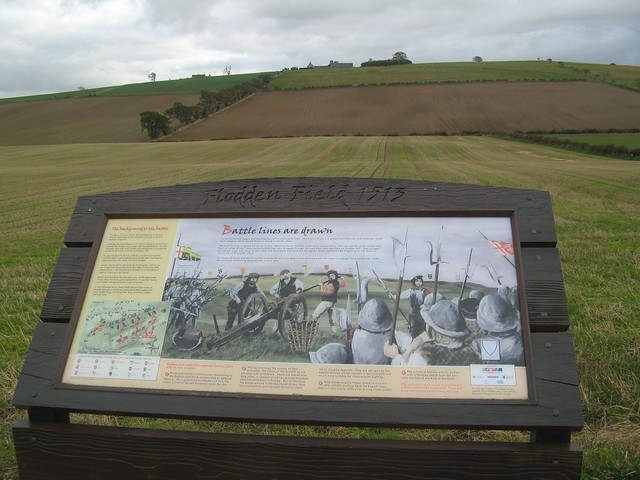
from Flickr (flickr)
Flodden Field Battlefield Branxton Northumberland North East
Pinned by Simon Cotterill
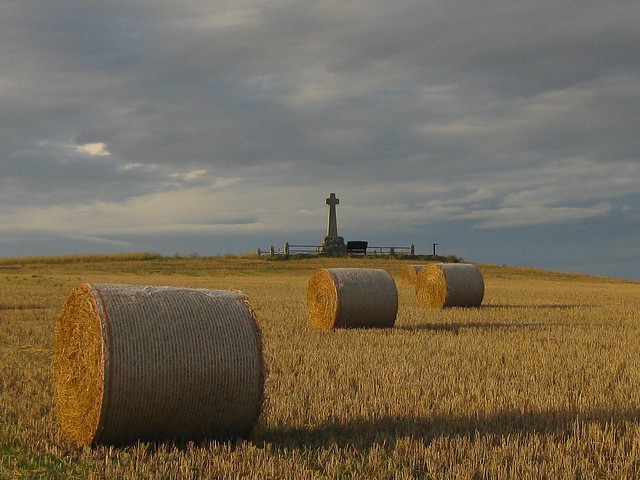
from Flickr (flickr)
Flodden battlefield - 14,000 died here. Now a peaceful home to corn straw.
Pinned by Simon Cotterill

from http://www.flodden1513.com/
Flodden 1513 Ecomuseum
- The Flodden 1513 Ecomuseum is an open museum which links together over 40 sites and other aspects of heritage nationwide which have a connection to the Battle of Flodden, through …
Added by
Simon Cotterill
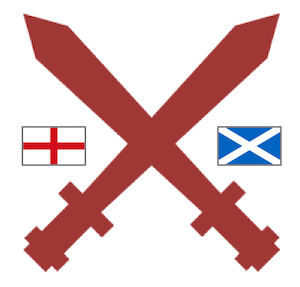
Co-Curate Page
Anglo-Scottish Wars
- This is not an exhaustive list! Can you contribute to the Visual Timeline? 937 Battle of Brunanburh 1018 Battle of Carham 1093 Battle of Alnwick 1174 …

Co-Curate Page
Surrey House, Haugh Head
- Overview Map Surrey House in Haugh Head lis located beside the A697 road about a mile from Wooler. It was was built in the mid-19th century. The building is a former coaching …
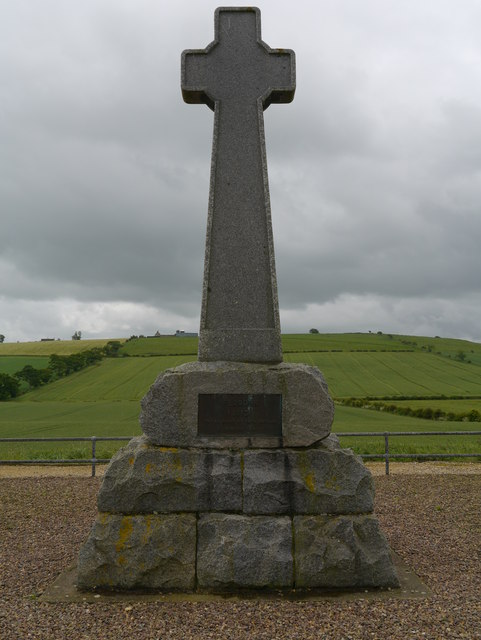
Co-Curate Page
Flodden Memorial
- Overview Map Street View The memorial to the thousnds of Scots and English killed in the Battle of Flodden Field (1513) is located on the site of the battlefield, less than …
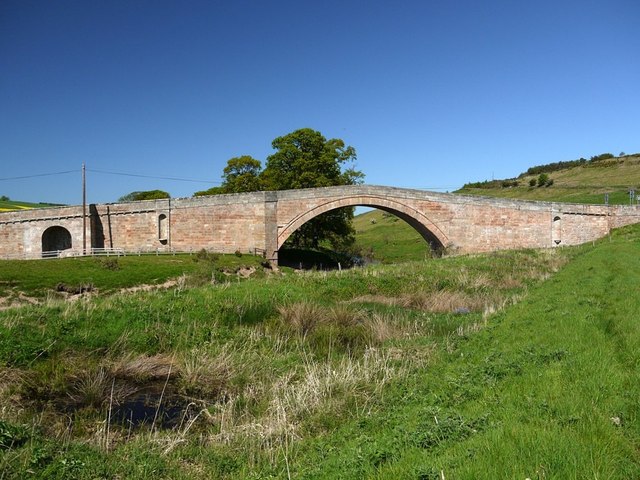
Co-Curate Page
Weetwood Bridge, over River Till
- Overview Map Street View Weetwood Bridge is a single span stone bridge over the River Till, located near Weetwood Hall, and about a mile and a half north-east of Wooler and …
from https://www.britishbattles.co…
Sir Guiscard Harbottle
- Amongst those of note killed on the English side at the Battle of Flodden was Sir Guiscard (Wynchard) Harbottle, Constable of Prudhoe Castle and son of Sir Ralph Harbottle of …
Added by
Ian Harbottle


from Flickr (flickr)
Flodden Field Battlefield Branxton Northumberland North East
Pinned by Simon Cotterill

from Flickr (flickr)
Flodden battlefield - 14,000 died here. Now a peaceful home to corn straw.
Pinned by Simon Cotterill

from http://www.flodden1513.com/
Flodden 1513 Ecomuseum
- The Flodden 1513 Ecomuseum is an open museum which links together over 40 sites and other aspects of heritage nationwide which have a connection to the Battle of Flodden, through …
Added by
Simon Cotterill

Co-Curate Page
Anglo-Scottish Wars
- This is not an exhaustive list! Can you contribute to the Visual Timeline? 937 Battle of Brunanburh 1018 Battle of Carham 1093 Battle of Alnwick 1174 …

Co-Curate Page
Surrey House, Haugh Head
- Overview Map Surrey House in Haugh Head lis located beside the A697 road about a mile from Wooler. It was was built in the mid-19th century. The building is a former coaching …

Co-Curate Page
Flodden Memorial
- Overview Map Street View The memorial to the thousnds of Scots and English killed in the Battle of Flodden Field (1513) is located on the site of the battlefield, less than …

Co-Curate Page
Weetwood Bridge, over River Till
- Overview Map Street View Weetwood Bridge is a single span stone bridge over the River Till, located near Weetwood Hall, and about a mile and a half north-east of Wooler and …
from https://www.britishbattles.co…
Sir Guiscard Harbottle
- Amongst those of note killed on the English side at the Battle of Flodden was Sir Guiscard (Wynchard) Harbottle, Constable of Prudhoe Castle and son of Sir Ralph Harbottle of …
Added by
Ian Harbottle
